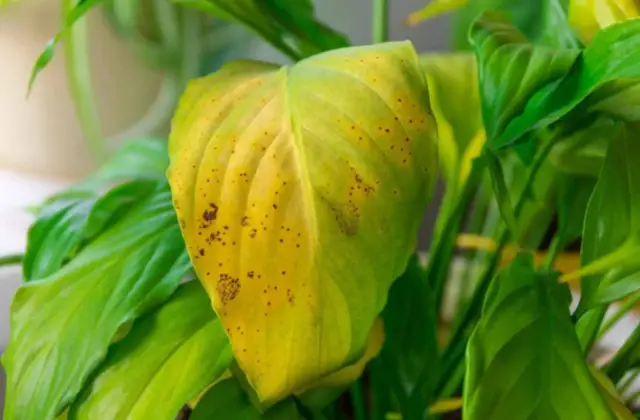Yellowing leaves on your beloved houseplants can be quite frustrating. Fortunately, there are several reasons behind this phenomenon, and understanding them can help you take corrective action. Let’s dive into the most common causes and how to remedy them.

Plant Leaves Turning Yellow
1. Moisture Stress
Culprit: Overwatering or underwatering.
Explanation: Proper watering is crucial for healthy plants. If your indoor plant’s leaves turn yellow, check the soil in the pot. Is it dry or soaked? Overwatering leads to waterlogged soil, suffocating the roots. Underwatering causes leaves to drop as the plant conserves water.
Solution: Adjust your watering routine. Ensure the soil is consistently moist but not waterlogged. Remember, patience is key—new leaves may emerge during the next growing season.
2. Normal Aging
Culprit: Natural part of plant growth.
Explanation: As plants age, lower leaves often turn yellow and drop off. This is normal. If your plant becomes too leggy, consider trimming back the main stem to encourage new growth and bushiness.
3. Cold Drafts
Culprit: Exposure to cold drafts.
Explanation: Tropical plants near air-conditioner vents or drafty windows may develop yellow leaves. Cold drafts stress the plant, causing leaf discoloration.
Solution: Relocate the plant to a less turbulent area. Monitor if the yellowing spreads further.
4. Nutrient Deficiencies

Culprit: Lack of essential nutrients.
Explanation: Yellowing leaves can result from deficiencies in nitrogen, iron, or other vital nutrients. Soil quality and fertilization play a significant role.
Solution: Use a balanced fertilizer or amend the soil with necessary nutrients. Follow recommended guidelines.
5. Pests and Diseases
Culprit: Insects or pathogens.
Explanation: Pests like spider mites, aphids, or fungal diseases can cause yellowing leaves. Inspect your plant carefully.
Solution: Treat pests promptly with appropriate measures. Isolate infected plants to prevent spread.
6. Improper Light
Culprit: Insufficient or excessive light.
Explanation: Incorrect light levels affect chlorophyll production. Too little light leads to yellowing, while too much light can scorch leaves.
Solution: Adjust the plant’s location based on its light requirements. Consider using artificial grow lights if needed.
7. Transplant Shock
Culprit: Stress from repotting.
Explanation: Transplanting can shock plants, causing yellowing leaves. Give them time to adjust.
Solution: Be gentle during repotting. Gradually introduce the plant to its new environment.
8. Environmental Stress
Culprit: Extreme temperatures, humidity fluctuations, or chemical exposure.
Explanation: Drastic environmental changes stress plants, affecting leaf health.
Solution: Maintain consistent conditions. Avoid sudden temperature shifts or exposure to harmful chemicals.
Remember, each plant is unique, so observe your green companions closely. By addressing these common issues, you’ll help your plants thrive and keep those leaves vibrant and green! 🌿
Frequently Asked Questions (FAQs) Related to Plant Leaves Turning Yellow
- Why do plant leaves turn yellow?
- Yellowing leaves can occur due to various reasons, including overwatering, nutrient deficiencies, pests, diseases, and environmental stress.
- Is yellowing normal for all plants?
- In some cases, yellow leaves are a natural part of a plant’s life cycle, especially in evergreen shrubs and trees.
- How can I tell if my plant is overwatered?
- Overwatering can lead to yellowing leaves. Check the soil moisture and ensure proper drainage to prevent waterlogged roots.
- What nutrients cause yellowing leaves?
- Nitrogen deficiency results in yellowing young leaves, while potassium deficiency causes yellowing around leaf edges. Iron deficiency leads to yellowing between veins.
- What if my plant is underwatered?
- Yellowing of young leaves may indicate insufficient water. Test the soil moisture by inserting a finger or lifting the pot to check its weight.
- Can low light cause yellow leaves?
- Yes, inadequate light affects chlorophyll production, leading to yellowing leaves. Adjust your plant’s location based on its light requirements.
- How does transplant shock affect leaves?
- Transplanting can stress plants, causing yellowing leaves. Be gentle during repotting and allow time for adjustment.
- What environmental factors contribute to yellowing leaves?
- Extreme temperatures, humidity fluctuations, and exposure to harmful chemicals can stress plants and affect leaf health.
- Are pests responsible for yellow leaves?
- Yes, pests like spider mites and aphids can suck plant sap, leading to yellowing leaves. Prompt treatment is essential.
- How can I prevent yellowing due to cold drafts?
- Relocate tropical plants away from air-conditioner vents or drafty windows to avoid cold stress.
- What’s the role of proper fertilization in preventing yellow leaves?
- Use balanced fertilizers or amend soil with necessary nutrients to prevent deficiencies that cause yellowing.
- Can yellowing leaves be due to chemical exposure?
- Yes, exposure to harmful chemicals can stress plants and affect leaf color.
- What’s the long-term solution for iron deficiency?
- Repot acid-loving plants into lime-free or ericaceous compost to address iron deficiency.
- How can I prevent yellowing due to low light?
- Place light-demanding houseplants in well-lit areas to maintain healthy green leaves.
- What’s the term for yellowing leaves?
- The horticultural term for yellow leaves is chlorosis.
- Why do older leaves turn yellow first?
- Overwatering often affects older leaves before younger ones. Ensure proper drainage and adjust watering.
- What’s the impact of cold drafts on leaves?
- Cold drafts stress plants and cause leaf discoloration. Relocate affected plants.
- How can I diagnose yellowing leaves?
- Consider factors like watering, light, nutrients, pests, and environmental conditions to identify the cause.
- What’s the connection between pests and yellow leaves?
- Pests like spider mites and aphids can suck plant sap, leading to yellowing leaves.
- What’s the best way to keep leaves green?
- Address underlying issues promptly, maintain consistent conditions, and observe your plants closely
Sources:




